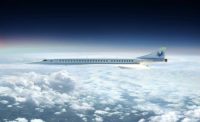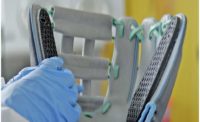After a nearly 20-year hiatus, supersonic passenger travel is about to make a comeback. One of the companies leading the charge is Boom Supersonic Inc. By the end of this decade, it plans to produce a 199-foot-long plane called Overture that will carry 65 to 88 passengers and fly at twice the speed of existing commercial jetliners.
Boom hopes to fill a void in the marketplace that has existed since the last Concorde flew in 2003. It recently unveiled a one-third scale demonstrator dubbed the XB-1 “Baby Boom” that will begin test flights later this year.
The next step will be to produce a full-size prototype of the Overture. Several customers, including Japan Airlines and Virgin Group, have already placed orders for the innovative aircraft made out of carbon-fiber composite.
Additive manufacturing technology is playing a key role in the development process. Boom engineers are using 3D-printed titanium flight-hardware components, such as complex heat-resistant air ducts. In fact, the XB-1 features 21 printed components.
“There’s a great deal of design flexibility in using 3D-printed materials,” says Byron Young, propulsion structure engineer at Boom Supersonic. “You might be able to achieve similar results by making multiple parts and welding or bolting them together, or by using complex carbon-fiber tools. But, that requires a lot of engineering time, and often more manufacturing time as well.”
“Much of the time and effort in aircraft design goes into joints,” explains Young. “By designing directly for additive manufacturing, we can reduce the number of parts and joints, which also reduces time and net effort. And, part consolidation cuts out significant amounts of weight—something that’s a major priority in aircraft design.”
Many of Boom’s printed parts relate to channeling air and contain complex vanes, ducts and louvers. Some of the air being routed through these components exceeds 500 F. The geometric complexity of these parts required a surface-based design approach.
“If fast moving air is touching it, we care about that surface from an efficiency and performance standpoint,” says Young. “So, when designing these parts, you generally start with aerodynamic profiles and then trim, fillet and thicken surfaces to create the solid part itself. The resulting parts are very complex—which meant they definitely needed to be fabricated through additive manufacturing.”
To produce printed parts, Young and his colleagues have been working closed with Velo3D Inc., a leading supplier of metal additive manufacturing equipment, and Duncan Machine Products Inc., a contract manufacturer.
“Boom [engineers] designed all these parts specifically for their novel aircraft,” says Gene Miller, applications engineer at Velo3D. “The unique types of geometries they created for directing flow, with a focus on weight savings, couldn’t be done with sheet metal, casting or any other way. To reap the benefits of complex design and weight reduction together, the only option was to do it with metal additive manufacturing.”
The Boom Supersonic team decided to use laser powder-bed fusion (LPBF) technology. All parts were printed on Velo3D’s Sapphire system, including many titanium components (a right and a left version for many of them) located in critical areas of the plane.
Printed parts include manifolds for the variable bypass valve system that routes air released by the engine compressor to the aircraft’s outer mold line (OML); exit louvers for the environmental control system that cools the cockpit and systems bay; louvers that direct the center inlet’s secondary bleed flow to the OML; and NACA ducts and diverter flange parts that capture exterior air and channel it into the aircraft to cool the engine bays.
Additive manufacturing enabled the Boom engineers to create complex supersonic parts, which are much more challenging to produce than traditional aircraft components.
“Additive manufacturing offers a very wide freedom of design, enabling the designer’s true intent to be materialized,” explains Miller. “Additionally, parts can be manufactured incredibly quickly without the need for expensive tooling, so design iteration occurs rapidly, which expedites performance optimization of complex parts.
“Supersonic aircraft components are usually designed with a more challenging application criteria,” Miller points out. “These include higher temperature gradient environments, more strict weight requirements, tighter tolerances and more challenging packaging constraints.
“Legacy manufacturing processes have different limitations than additive manufacturing,” adds Miller. “For example, casting is limited by parting lines, undercuts and cores. Machining is limited by accessibility of cutting tools. Because these are not applicable to additive manufacturing, producing more complex, amalgamated parts becomes possible.”
One of the biggest challenges of the Boom project was working with titanium, which has a reputation in the aerospace industry for being delicate and difficult to work with. Traditionally, titanium parts are manufactured via casting, which has a slower cooling rate to prevent cracking.
“Metallurgically, titanium behaves differently than most other alloys during LPBF,” explains Miller. “The result is a strong, but brittle as-printed material. This is advantageous in small features which will exhibit a lesser degree of local deformation. However, on large features, internal stresses accumulate and cracking becomes more likely.
“The extremely thin walls in the aircraft hardware designs would have been nearly impossible to cast,” claims Miller. “That’s really one of the driving forces behind using 3D printing for these parts. We can print large, thin-walled titanium sections without the high scrap rate of cracked cast parts.”
The parts printed for Boom utilized flanges and gaskets, and were attached with mechanical fasteners.
According to Miller, there are many potential future applications for additive manufacturing in the aerospace industry.
“Designs that were compromised for manufacturability, as well as parts with long lead times, make terrific candidates for additive manufacturing,” explains Miller. “I see opportunities for [the technology] in structural components that can be optimized, as well as engine components with long lead times.
“Additive manufacturing has catalyzed innovation to the point where design is beholden only to designers’ ingenuity,” adds Miller. “However, certification of flight hardware is the gateway to future applications in the aerospace industry.
“This is something [we are] targeting with Assure, our quality validation software,” says Miller. “Additive manufacturability is more than just the ability to print parts; it is about the ability to prove that quality is maintained in every print.”






